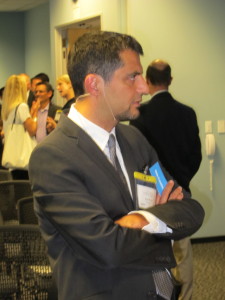Santa Clara County is drawing tech and other crucial workplace talent from elite universities and emerging technology clusters nationwide even as it is losing the local war for workers to San Francisco, San Mateo and Alameda counties.
By Sharon Simonson
Santa Clara County is the biggest supplier to San Francisco and neighboring counties of the high-value tech and other skilled workers who drive the region’s economy.
According to new U.S. Census Bureau migration data, San Francisco, San Mateo and Alameda counties draw the largest share of their new high-skill workers, including tech employees, business managers, scientists and industrial artists, from Santa Clara County. Based on net flows — the difference between the number of workers moving in and the number of workers moving out — the three counties are absorbing more than 2,800 high-value employees each year from their southern neighbor.
To keep its own new-talent pipeline full, Silicon Valley is tapping upper Midwest and Northeast locations with world-renowned universities and places such as Boulder, Colo., with respected universities and emerging high-tech industry clusters.
Technology workers, a subset of the high-skill workers whose migration the Census Bureau tracks, drive economic activity much more strongly even than traditional manufacturing, University of California, Berkeley, economist Enrico Moretti told the Northern California chapter of CoreNet at its August meeting. While only 15 percent to 18 percent of the jobs in the Bay Area are in the tech sector, those “innovation” jobs generate demand for services that help to employ another 65 percent of the region’s workers.

For every one job created in the technology sector, five additional jobs are created outside tech, largely among service professions from retail salespeople to architects and engineers, Moretti said: “That is a huge multiplier.” In comparison, a traditional manufacturing job creates 1.6 jobs outside its sector.
The difference “is partly that tech pays more than traditional manufacturing but also that the tech industry uses local services a lot,” Moretti said. The author of the 2012 book “The New Geography of Jobs” said his research has focused on understanding the economic relationship between tech workers and service providers.
Companies such as Facebook Inc. and Uber Inc. are based in the Bay Area but are international merchants. “The tech sector brings in the wealth from the rest of the globe,” he said.
To be sure, San Francisco, San Mateo and Alameda counties are gaining hundreds of high-skilled workers each year from well-known tech centers outside the Bay Area, according to the county-to-county annual migration data.
Together San Francisco and Alameda add nearly 700 workers each year by drawing from New York City’s boroughs and their New Jersey suburbs. San Francisco, Alameda and San Mateo counties also are adding hundreds of workers a year from the Boston area, and a smattering from Philadelphia, an early-stage tech market, according to research by real estate services company Jones Lang LaSalle.
But in many cases, just as many or more of the high-value workers are leaving the Bay Area, bound for the same high-tech metropolitan centers that others have left. Santa Clara County is gaining some two-dozen new high-skill workers a year from Worcester County, Mass., a suburb of Boston, for instance. But on average it loses 10 times that many a year to five other Boston-area counties, including Suffolk, home to Boston itself.
True additions to the Bay Area stable of tech and scientific talent are coming largely from other California counties, notably Los Angeles and San Diego; from a handful of counties nationally with emerging tech-industry clusters; and from five counties that arguably have among the world’s most promising minds: the University of Wisconsin, Madison (Dane County); Penn State University (Centre County); the University of Michigan, Ann Arbor (Washtenaw County); the University of Chicago (Cook County), and New York’s Cornell University (Tompkins County). All five universities rank among the most elite in the world, according to The Economist.
Mountain View-based Google Inc. already has engineering and design offices in Madison, according to the Wisconsin State Journal. Campbell-based Barracuda Networks has a 42,000 square-foot research and development space in downtown Ann Arbor.
In February, Google announced it would expand its Pittsburgh operations by 66,000 square feet to 200,000 square feet, including the construction of a new building, in one of three emerging tech clusters. The deal was “arguably the most influential high-tech development in Pittsburgh over the last year,” according to Jones Lang.
The real estate company tags Pittsburgh a “growing early stage” tech market, bolstered by the presence of Carnegie Mellon University, which has a Silicon Valley campus, and the University of Pittsburgh. The city has not quite 30,000 high-tech employees. That compares to more than 213,000 in Silicon Valley.